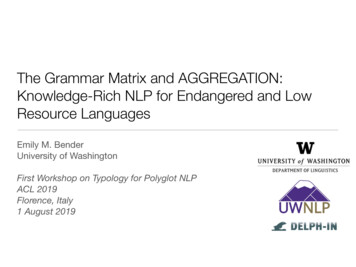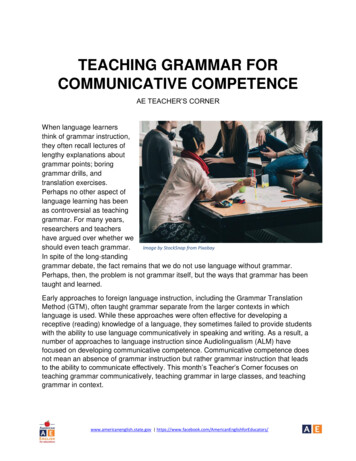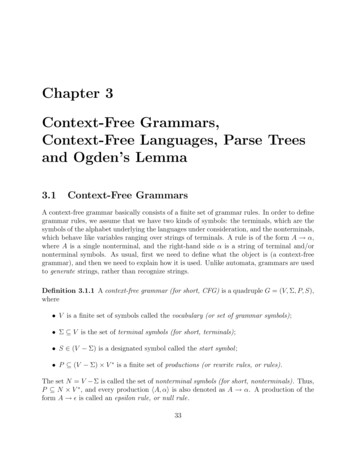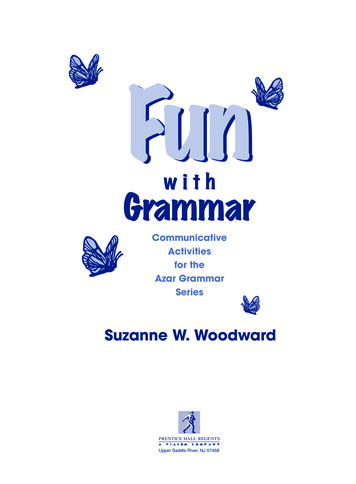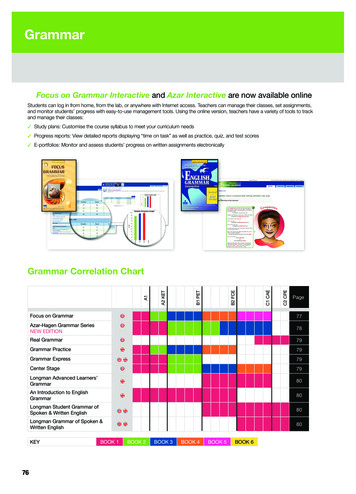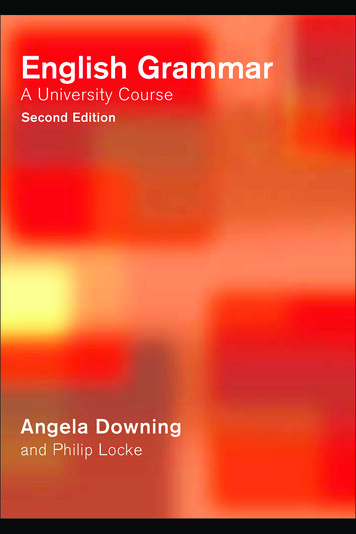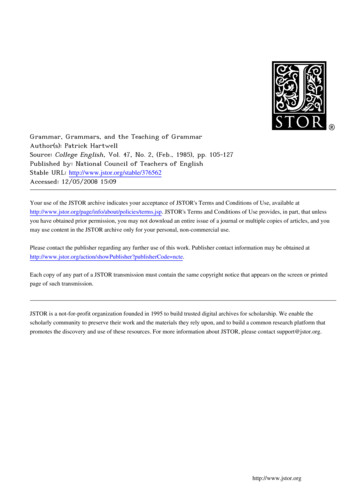
Transcription
Grammar, Grammars, and the Teaching of GrammarAuthor(s): Patrick HartwellSource: College English, Vol. 47, No. 2, (Feb., 1985), pp. 105-127Published by: National Council of Teachers of EnglishStable URL: http://www.jstor.org/stable/376562Accessed: 12/05/2008 15:09Your use of the JSTOR archive indicates your acceptance of JSTOR's Terms and Conditions of Use, available rms.jsp. JSTOR's Terms and Conditions of Use provides, in part, that unlessyou have obtained prior permission, you may not download an entire issue of a journal or multiple copies of articles, and youmay use content in the JSTOR archive only for your personal, non-commercial use.Please contact the publisher regarding any further use of this work. Publisher contact information may be obtained herCode ncte.Each copy of any part of a JSTOR transmission must contain the same copyright notice that appears on the screen or printedpage of such transmission.JSTOR is a not-for-profit organization founded in 1995 to build trusted digital archives for scholarship. We enable thescholarly community to preserve their work and the materials they rely upon, and to build a common research platform thatpromotes the discovery and use of these resources. For more information about JSTOR, please contact support@jstor.org.http://www.jstor.org
Patrick HartwellGrammar,Grammars,andtheTeachingof GrammarFor me the grammar issue was settled at least twenty years ago with the conclusion offered by Richard Braddock, Richard Lloyd-Jones, and Lowell Schoer in1963.In view of the widespreadagreementof research studies based upon many types ofstudentsand teachers, the conclusion can be stated in strongand unqualifiedterms:the teaching of formal grammarhas a negligible or, because it usually displacessome instruction and practice in composition, even a harmfuleffect on improvement in writing.1Indeed, I would agree with Janet Emig that the grammar issue is a prime example of "magical thinking": the assumption that students will learn only what weteach and only because we teach.2But the grammar issue, as we will see, is a complicated one. And, perhapssurprisingly, it remains controversial, with the regular appearance of papers defending the teaching of formal grammar or attacking it.3 Thus Janice Neuleib,1. Researchin WrittenComposition(Urbana,Ill.: NationalCouncilof Teachersof English, 1963),pp. 37-38.2. llyin Schools," in WritingProcess,Development and Communication, Vol. II of Writing: The Nature, Development and Teaching ofWrittenCommunication,ed. CharlesH. Frederiksenand Joseph F. Dominic(Hillsdale,N.J.: Lawrence Erlbaum,1980),pp. 21-30.3. For argumentsin favor of formalgrammarteaching, see PatrickF. Basset, "Grammar-CanWe Afford Not to Teach It?" NASSP Bulletin, 64, No. 10 (1980), 55-63; Mary Epes, et al., "TheCOMP-LABProject:Assessing the Effectivenessof a Laboratory-CenteredBasic WritingCourseonthe College Level" (Jamaica, N.Y.: York College, CUNY, 1979) ERIC 194 908; June B. Evans,"The AnalogousOunce:The Analgesicfor Relief," EnglishJournal,70, No. 2 (1981),38-39;SydneyGreenbaum,"What Is Grammarand Why Teach It?" (a paperpresentedat the meetingof the National Council of Teachers of English, Boston, Nov. 1982) ERIC 222 917; MarjorieSmelstor, AGuide to the Role of Grammar in Teaching Writing (Madison: University of Wisconsin School of Education, 1978) ERIC 176 323; and A. M. Tibbetts, Working Papers: A Teacher's Observations onComposition(Glenview,Ill.: Scott, Foresman, 1982).For attackson formalgrammarteaching,see HarveyA. Daniels,FamousLast Words:TheAmerPatrickHartwell,Professor of English at IndianaUniversityof Pennsylvania,is the co-author,withRobert H. Bentley, of Open to Language: A New College Rhetoric (Oxford University Press, 1982).ProfessorHartwellwishes to thank Wayne Edkin, Camden(New York) Public Schools; MichaelMarler,BrighamYoung University-Hawaii;and Ron Shook, Utah State University, for discussingthese issues with him, and particularlyto thank his colleague Dan J. Tannacitofor referencesanddiscussion.College English, Volume 47, Number 2, February 1985105
106College Englishwritingon "The Relation of Formal Grammarto Composition"in College Composition and Communication (23 [1977], 247-50), is tempted "to sputter on pa-per" at reading the quotation above (p. 248), and MarthaKolln, writing in thesame journal three years later ("Closing the Books on Alchemy," CCC, 32[1981], 139-51), labels people like me "alchemists" for our perverse beliefs.Neuleib reviews five experimentalstudies, most of them concludingthat formalgrammarinstructionhas no effect on the qualityof students' writingnor on theirability to avoid error. Yet she renders in effect a Scots verdict of "Not proven"and calls for more research on the issue. Similarly,Kolln reviews six experimental studies that arrive at similarconclusions, only one of them overlappingwiththe studies cited by Neuleib. She calls for more careful definition of the wordgrammar-her definitionbeing "the internalizedsystem that native speakers ofa languageshare" (p. 140)-and she concludes with a stirringcall to place grammar instructionat the center of the composition curriculum:"our goal should beto help students understand the system they know unconsciously as nativespeakers, to teach them the necessary categories and labels that will enable themto think about and talk about their language" (p. 150). Certainlyour textbooksand our pedagogies-though they vary widely in what they see as "necessarycategories and labels"- continue to emphasize mastery of formalgrammar,andpopulardiscussions of a presumed literacy crisis are almost unanimousin theircall for a renewed emphasis on the teaching of formalgrammar,seen as basic forsuccess in writing.4An InstructiveExampleIt is worth noting at the outset that both sides in this dispute-the grammariansand the anti-grammarians-articulate the issue in the same positivistic terms:what does experimentalresearch tell us about the value of teachingformalgrammar? But seventy-five years of experimentalresearch has for all practical purposes told us nothing. The two sides are unable to agree on how to interpretsuch research. Studies are interpretedin terms of one's prior assumptionsaboutthe value of teaching grammar:their results seem not to change those assumptions. Thus the basis of the discussion, a basis sharedby Kolin and Neuleib andby Braddock and his colleagues-"what does educationalresearch tell us?"seems designed to perpetuate, not to resolve, the issue. A single example will beinstructive. In 1976 and then at greater length in 1979, W. B. Elley, I. H. Barican Language Crisis Reconsidered(Carbondale:SouthernIllinois UniversityPress, 1983);SuzetteHaden Elgin, Never Mind the Trees: What the English Teacher Really Needs to Know about Lin-guistics (Berkeley: University of CaliforniaCollege of Education,Bay Area WritingProject Occasional PaperNo. 2, 1980)ERIC 198 536; Mike Rose, "RemedialWritingCourses:A Critiqueand aProposal." College English, 45 (1983), 109-128;and Ron Shook, "Response to MarthaKolln," College Composition and Communication, 34 (1983), 491-495.4. See, for example, Clifton Fadimanand James Howard, EmptyPages: A Search for WritingCompetence in School and Society (Belmont, Cal.: Fearon Pitman, 1979); Edwin Newman, A CivilTongue(Indianapolis,Ind.: Bobbs-Merrill,1976);and StrictlySpeaking(New York: WarnerBooks,1974);John Simons, Paradigms Lost (New York: ClarksonN. Potter, 1980);A. M. Tibbets andCharlene Tibbets, What's Happening to American English? (New York: Scribner's, 1978); and"WhyJohnnyCan't Write," Newsweek, 8 Dec. 1975,pp. 58-63.
Grammar, Grammars, and the Teaching of Grammar107ham, H. Lamb, and M. Wyllie reported on a three-year experiment in New Zealand, comparing the relative effectiveness at the high school level of instructionin transformational grammar, instruction in traditional grammar, and no grammar instruction.5 They concluded that the formal study of grammar, whethertransformational or traditional, improved neither writing quality nor control oversurface correctness.After two years, no differences were detected in writingperformanceor languagecompetence; after three years small differences appearedin some minor conventions favoringthe TG [transformationalgrammar]group, but these were more thanoffset by the less positive attitudes they showed towards their English studies. (p.18)Anthony Petroskey, in a review of research ("Grammar Instruction: What WeKnow," English Journal, 66, No. 9 [1977], 86-88), agreed with this conclusion,finding the study to be carefully designed, "representative of the best kind of educational research" (p. 86), its validity "unquestionable" (p. 88). Yet JaniceNeuleib in her essay found the same conclusions to be "startling" and questioned whether the findings could be generalized beyond the target population,New Zealand high school students. Martha Kolln, when her attention is drawnto the study ("Reply to Ron Shook," CCC, 32 [1981], 139-151), thinks the wholeexperiment "suspicious." And John Mellon has been willing to use the study todefend the teaching of grammar; the study of Elley and his colleagues, he has argued, shows that teaching grammar does no harm.6It would seem unlikely, therefore, that further experimental research, in andof itself, will resolve the grammar issue. Any experimental design can be nitpicked, any experimental population can be criticized, and any experimentalconclusion can be questioned or, more often, ignored. In fact, it may well bethat the grammar question is not open to resolution by experimental research,that, as Noam Chomsky has argued in Reflections on Language (New York:Pantheon, 1975), criticizing the trivialization of human learning by behavioralpsychologists, the issue is simply misdefined.There will be "good experiments" only in domains that lie outside the organism'scognitive capacity. For example, there will be no "good experiments"in the studyof humanlearning.This discipline . . . will, of necessity, avoid those domains in which an organismis specially designed to acquirerich cognitive structuresthat enter into its life in anintimatefashion. The discipline will be of virtuallyno intellectualinterest, it seemsto me, since it is restrictingitself in principleto those questions that are guaranteedto tell us little about the natureof organisms.(p. 36)5. "The Role of Grammarin a SecondarySchool EnglishCurriculum."Research in the Teachingof English, 10 (1976), 5-21; The Role of Grammar in a Secondary School Curriculum (Wellington:New ZealandCouncilof Teachersof English, 1979).6. "A Taxonomy of Compositional Competencies," in Perspectives on Literacy, ed. RichardBeach and P. David Pearson(Minneapolis:Universityof MinnesotaCollegeof Education,1979),pp.247-272.
108College EnglishAsking the Right QuestionsAs a result, though I will look briefly at the traditionof experimentalresearch,my primarygoal in this essay is to articulatethe grammarissue in differentand,I would hope, more productive terms. Specifically, I want to ask four questions:1. Why is the grammarissue so important?Why has it been the dominantfocus of composition researchfor the last seventy-five years?2. What definitions of the word grammar are needed to articulate thegrammarissue intelligibly?3. What do findings in cognate disciplines suggest about the value of formal grammarinstruction?4. What is our theory of language, and what does it predict about the valueof formal grammarinstruction?(This question-"what does our theoryof language predict?"-seems a much more powerful question than"what does educationalresearch tell us?")In exploring these questions I will attempt to be fully explicit about issues,terms, and assumptions. I hope that both proponents and opponents of formalgrammarinstructionwould agree that these are useful as shared points of reference: care in definition, full examination of the evidence, reference to relevantwork in cognate disciplines, and explicit analysis of the theoretical bases of theissue.But even with that gesture of harmonyit will be difficultto articulatethe issuein a balanced way, one that will be acceptable to both sides. After all, we aredealingwith a professional dispute in which one side accuses the other of "magical thinking," and in turn that side responds by charging the other as "alchemists." Thus we might suspect that the grammarissue is itself embedded inlargermodels of the transmissionof literacy, part of quite differentassumptionsabout the teaching of composition.Those of us who dismiss the teaching of formal grammarhave a model ofcomposition instruction that makes the grammarissue "uninteresting"in a scientific sense. Our model predicts a rich and complex interactionof learner andenvironment in mastering literacy, an interaction that has little to do with sequences of skills instructionas such. Those who defend the teachingof grammartend to have a model of composition instructionthat is rigidlyskills-centeredandrigidly sequential: the formal teaching of grammar,as the first step in that sequence, is the cornerstone or linchpin. Grammarteaching is thus supremelyinteresting, naturallya dominantfocus for educationalresearch. The controversyover the value of grammarinstruction, then, is inseparablefrom two other issues: the issues of sequence in the teaching of compositionand of the role of thecompositionteacher. Consider, for example, the force of these two issues in Janice Neuleib's conclusion: after calling for yet more experimentalresearchon thevalue of teaching grammar,she ends with an absolute (and unsupported)claimabout sequences and teacher roles in composition.We do know, however, that some things must be taught at different levels. Insis-
Grammar, Grammars, and the Teaching of Grammar109tence on adherence to usage norms by compositionteachers does improve usage.Studentscan learn to organizetheir papers if teachersdo not accept papersthat aredisorganized. Perhaps composition teachers can teach those two abilities beforethey begin the more difficulttasks of developingsyntactic sophisticationand a winning style. ("The Relationof FormalGrammarto Composition,"p. 250)(One might want to ask, in passing, whether "usage norms" exist in the monolithic fashion the phrase suggests and whether refusing to accept disorganizedpapers is our best available pedagogy for teaching arrangement.)7But I want to focus on the notion of sequence that makes the grammar issueso important: first grammar, then usage, then some absolute model of organization, all controlled by the teacher at the center of the learning process, withother matters, those of rhetorical weight-"syntacticsophistication and a winning style"-pushed off to the future. It is not surprising that we call each othernames: those of us who question the value of teaching grammar are in fact shaking the whole elaborate edifice of traditional composition instruction.The Five Meanings of "''Grammar"Given its centrality to a well-established way of teaching composition, I need togo about the business of defining grammar rather carefully, particularly in viewof Kolln's criticism of the lack of care in earlier discussions. Therefore I willbuild upon a seminal discussion of the word grammar offered a generation ago,in 1954, by W. Nelson Francis, often excerpted as "The Three Meanings ofGrammar."8 It is worth reprinting at length, if only to re-establish it as a reference point for future discussions.The first thing we mean by "grammar"is "the set of formal patternsin whichthe words of a languageare arrangedin orderto convey largermeanings." It is notnecessary that we be able to discuss these patterns self-consciouslyin order to beable to use them. In fact, all speakers of a language above the age of five or sixknow how to use its complex forms of organizationwith considerableskill; in thissense of the word-call it "Grammar 1"-they are thoroughly familiar with itsgrammar.The second meaning of "grammar"-call it "Grammar2"-is "the branch oflinguisticscience which is concerned with the description,analysis, and formulization of formallanguagepatterns." Just as gravitywas in full operationbefore Newton's apple fell, so grammarin the first sense was in full operationbefore anyoneformulatedthe first rule that began the history of grammaras a study.The third sense in which people use the word "grammar" is "linguistic etiquette." This we may call "Grammar3." The word in this sense is often coupledwith a derogatory adjective: we say that the expression "he ain't here" is "badgrammar." . . .As has already been suggested, much confusion arises from mixingthese meanings. One hears a good deal of criticism of teachers of English couched in suchterms as "they don't teach grammarany more." Criticismof this sort is based on7. On usage norms, see Edward Finegan, Attitudes toward English Usage: The History of a Warof Words (New York: Teachers College Press, 1980), and Jim Quinn, American Tongue in Cheek: APopulist Guide to Language (New York: Pantheon, 1980); on arrangement, see Patrick Hartwell,"Teaching Arrangement: A Pedagogy," CE, 40 (1979), 548-554.8. "Revolution in Grammar," Quarterly Journal of Speech, 40 (1954), 299-312.
110College Englishthe wholly unproven assumption that teaching Grammar2 will improve the student's proficiencyin Grammar1 or improve his mannersin Grammar3. Actually,the form of Grammar2 which is usually taughtis a very inaccurateand misleadinganalysis of the facts of Grammar1; and it thereforeis of highly questionablevaluein improvinga person's ability to handlethe structuralpatternsof his language.(pp.300-301)Francis' Grammar 3 is, of course, not grammar at all, but usage. One would liketo assume that Joseph Williams' recent discussion of usage ("The Phenomenology of Error," CCC, 32 (1981), 152-168), along with his references, has placedthose shibboleths in a proper perspective. But I doubt it, and I suspect that popular discussions of the grammar issue will be as flawed by the intrusion of usageissues as past discussions have been. At any rate I will make only passing reference to Grammar 3-usage-naivelyassuming that this issue has been discussedelsewhere and that my readers are familiar with those discussions.We need also to make further discriminations about Francis' Grammar 2,given that the purpose of his 1954 article was to substitute for one form of Grammar 2, that "inaccurate and misleading" form "which is usually taught," another form, that of American structuralist grammar. Here we can make use of astill earlier discussion, one going back to the days when PMLA was willing topublish articles on rhetoric and linguistics, to a 1927 article by Charles CarpenterFries, "The Rules of the Common School Grammars" (42 [1927], 221-237). Friesthere distinguished between the scientific tradition of language study (to whichwe will now delimit Francis' Grammar 2, scientific grammar) and the separatetradition of "the common school grammars," developed unscientifically, largelybased on two inadequate principles-appeals to "logical principles," like "twonegatives make a positive," and analogy to Latin grammar; thus, CharltonLaird's characterization, "the grammar of Latin, ingeniously warped to suggestEnglish" (Language in America [New York: World, 1970], p. 294). There is, ofcourse, a direct link between the "common school grammars" that Fries criticized in 1927 and the grammar-based texts of today, and thus it seems wise, asKarl W. Dykema suggests ("Where Our Grammar Came From," CE, 22 (1961),455-465), to separate Grammar 2, "scientific grammar," from Grammar 4,"school grammar," the latter meaning, quite literally, "the grammars used inthe schools."Further, since Martha Kolln points to the adaptation of Christensen's sentence rhetoric in a recent sentence-combining text as an example of the properemphasis on "grammar" ("Closing the Books on Alchemy," p. 140), it is worthseparating out, as still another meaning of grammar, Grammar 5, "stylisticgrammar," defined as "grammatical terms used in the interest of teaching prosestyle." And, since stylistic grammars abound, with widely variant terms and emphases, we might appropriately speak parenthetically of specific forms of Grammar 5-Grammar 5 (Lanham); Grammar 5 (Strunk and White); Grammar 5(Williams, Style); even Grammar 5 (Christensen, as adapted by Daiker, Kerek,and Morenberg).99. RichardA. Lanham,Revising Prose (New York: Scribner's,1979);WilliamStrunkand E. B.
Grammar, Grammars, and the Teaching of GrammarIllThe Grammarin Our HeadsWith these definitions in mind, let us return to Francis' Grammar1, admirablydefinedby Kolln as "the internalizedsystem of rules that speakersof a languageshare" ("Closing the Books on Alchemy," p. 140), or, to put it more simply, thegrammarin our heads. Three features of Grammar1 need to be stressed:first, itsspecial status as an "internalized system of rules," as tacit and unconsciousknowledge;second, the abstract, even counterintuitive,natureof these rules, insofar as we are able to approximatethem indirectly as Grammar2 statements;and third, the way in which the form of one's Grammar1 seems profoundlyaffected by the acquisition of literacy. This sort of review is designed to firm upour theory of language, so that we can ask what it predicts about the value ofteachingformalgrammar.A simple thought experiment will isolate the special status of Grammar 1knowledge. I have asked members of a numberof differentgroups-from sixthgradersto college freshmen to high-school teachers-to give me the rule for orderingadjectives of nationality, age, and numberin English. The response is always the same: "We don't know the rule." Yet when I ask these groups to perform an active language task, they show productive control over the rule theyhave denied knowing. I ask them to arrange the following words in a naturalorder:FrenchtheyounggirlsfourI have never seen a native speaker of English who did not immediatelyproducethe naturalorder, "the four young French girls." The rule is that in English theorder of adjectives is first, number, second, age, and third, nationality. Nativespeakers can create analogous phrases using the rule- "the seventy-three agedScandinavianlechers"; and the drive for meaningis so great that they will createcontexts to make sense out of violations of the rule, as in foregroundingfor emphasis: "I want to talk to the French four young girls." (I immediatelyenvisiona large room, perhaps a banquet hall, filled with tables at which are seatedgroups of four young girls, each group of a differentnationality.)So Grammar1is eminently usable knowledge-the way we make our life throughlanguagebut it is not accessible knowledge; in a profoundsense, we do not know that wehave it. Thus neurolinguist Z. N. Pylyshyn speaks of Grammar1 as "autonomous," separatefrom common-sense reasoning, and as "cognitively impenetrable," not available for direct examination.10In philosophy and linguistics, thedistinction is made between formal, conscious, "knowing about" knowledgeWhite, The Elements of Style, 3rd ed. (New York: Macmillan, 1979); Joseph Williams, Style: TenLessons in Clarity and Grace (Glenview, Ill.: Scott, Foresman, 1981); Christensen, "A GenerativeRhetoric of the Sentence," CCC, 14 (1963), 155-161; Donald A. Daiker, Andrew Kerek, and MaxMorenberg, The Writer's Options: Combining to Composing, 2nd ed. (New York: Harper & Row,1982).10. "A Psychological Approach," in Psychobiology of Language, ed. M. Studdert-Kennedy(Cambridge, Mass.: MIT Press, 1983), pp. 16-19. See also Noam Chomsky, "Language and Unconscious Knowledge," in Psychoanalysis and Language: Psychiatry and the Humanities, Vol. III, ed.Joseph H. Smith (New Haven, Conn.: Yale University Press, 1978), pp. 3-44.
112College English(like Grammar2 knowledge) and tacit, unconscious, "knowinghow" knowledge(like Grammar1 knowledge). The importanceof this distinctionfor the teachingof composition-it provides a powerful theoreticaljustification for mistrustingthe ability of Grammar2 (or Grammar4) knowledge to affect Grammar1 performance-was pointed out in this journal by Martin Steinmann, Jr., in 1966("RhetoricalResearch," CE, 27 [1966], 278-285).Further,the more we learn about Grammar1-and most linguistswould agreethat we know surprisinglylittle about t-the more abstractand implicitit seems.This abstractness can be illustratedwith an experiment, devised by Lise Mennand reportedby Morris Halle,11about our rule for formingplurals in speech. Itis obvious that we do indeed have a "rule" for formingplurals, for we do notmemorize the plural of each noun separately. You will demonstrateproductivecontrol over that rule by forming the spoken plurals of the nonsense words below:tholeflitchplastHalle offers two ways of formalizinga Grammar2 equivalentof this Grammar1 ability. One form of the rule is the following, stated in terms of speech sounds:a. If the noun ends in /s z s z c j/, add /Iz/;b. otherwise, if the noun ends in /p t k f 0/, add /s/;c. otherwise, add /z/.11This rule comes close to what we literate adults consider to be an adequaterulefor pluralsin writing, like the rules, for example, taken from a recent "commonschool grammar," Eric Gould's Reading into Writing: A Rhetoric, Reader, andHandbook(Boston: Houghton Mifflin, 1983):Plurals can be tricky. If you are unsure of a plural,then check it in the dictionary.The generalrules areAdd s to the singular:girls, tablesAdd es to nouns endingin ch, sh, x or s: churches, boxes, wishesAdd es to nouns endingin y and precededby a vowel once you have changedy to i:monies, companies. (p. 666)(But note the persistent inadequacyof such Grammar4 rules: here, as I read it,the rule is inadequateto explain the plurals of ray and tray, even to explain thecollective noun monies, not a plural at all, formed from the mass noun moneyand offered as an example.) A second form of the rule would make use of muchmore abstractentities, sound features:a. If the noun ends with a sound that is [coronal, strident],add lIz!;b. otherwise, if the noun ends with a sound that is [non-voiced],add Is!;c. otherwise, add /z/.(The notion of "sound features" is itself ratherabstract,perhapsnew to readers11. MorrisHalle, "Knowledge Unlearnedand Untaught:WhatSpeakersKnow aboutthe Soundsof Their Language," in Linguistic Theory and Psychological Reality, ed. Halle, Joan Bresnan, andGeorgeA. Miller(Cambridge,Mass.: MIT Press, 1978),pp. 135-140.
Grammar, Grammars, and the Teaching of Grammar113not trained in linguistics. But such readers should be able to recognize that thespoken plurals of lip and duck, the sound [s], differ from the spoken plurals ofsea and gnu, the sound [z], only in that the sounds of the latter are "voiced"one's vocal cords vibrate-while the sounds of the formerare "non-voiced.")To test the psychologically operative rule, the Grammar1 rule, native speakers of English were asked to form the plural of the last name of the composerJohannSebastianBach, a sound [x], uniquein American(thoughnot in Scottish)English. If speakers follow the first rule above, using word endings, they wouldreject a) and b), then apply c), producingthe pluralas /baxz/, with word-final/z/.(If writers were to follow the rule of the common school grammar,they wouldproduce the written plural Baches, apparently, given the form of the rule, onanalogy with churches.) If speakers follow the second rule, they would have toanalyze the sound [x] as [non-labial,non-coronal,dorsal, non-voiced, and nonstrident],producing the plural as /baxs/, with word-final/s/. Native speakers ofAmericanEnglish overwhelminglyproduce the pluralas /baxs/. They use knowledge that Halle characterizesas "unlearnedand untaught"(p. 140).Now such a conclusion is counterintuitive-certainly it departs maximallyfrom Grammar4 rules for formingplurals. It seems that native speakers of English behave as if they have productive control, as Grammar1 knowledge, of abstract sound features ( coronal, ? strident, and so on) which are availableasconscious, Grammar2 knowledge only to trained linguists-and, indeed, formally availableonly within the last hundredyears or so. ("Behave as if," in thatlast sentence, is a necessary hedge, to underscore the difficulty of "knowingabout" Grammar1.)Moreover, as the example of pluralrules suggests, the form of the Grammar1in the heads of literate adults seems profoundlyaffected by the acquisitionof literacy. Obviously, literate adults have access to different morphologicalcodes:the abstract print -s underlyingthe predictable/s/ and /z/ plurals, the abstractprint -ed underlyingthe spoken past tense markersIt!, as in "walked," /ld/, asin "surrounded,"/d!, as in "scored," and the symbol /01 for no surface realization, as in the relaxed standardpronunciationof "I walked to the store." Literate adults also have access to distinctionspreservedonly in the code of print(forexample, the distinction between "a good sailer" and "a good sailor" that MarkAranoff points out in "An English Spelling Convention," Linguistic Inquiry, 9[1978], 299-303). More significantly,Irene Moscowitz speculates that the abilityof thirdgradersto form abstractnouns on analogy with pairs like divine::divinityand serene::serenity, where the spoken vowel changes but the spellingpreservesmeaning,is a factor of knowing how to read. Carol Chomskyfinds a three-stagedevelopmentalsequence in the grammaticalperformanceof seven-year-olds,related to measures of kind and variety of reading;and Rita S. Brause finds a ninestage developmental sequence in the ability to understandsemantic ambiguity,extending from fourth graders to graduate students.12 John Mills and Gordon12. Moscowitz, "On the Status of Vowel Shift in English," in Cognitive Development and theAcquisition of Language, ed. T. E. Moore (New York: Academic Press, 1973
students and teachers, the conclusion can be stated in strong and unqualified terms: the teaching of formal grammar has a negligible or, because it usually displaces some instruction and practice in composition, even a harmful effect on improve- ment in writing.1 Indeed, I would agree with Janet Emig

